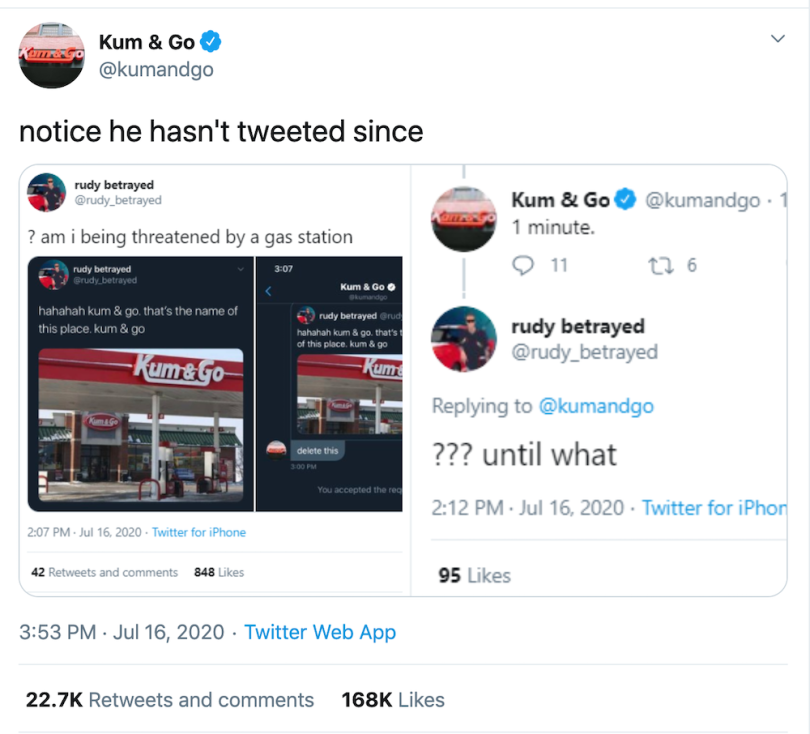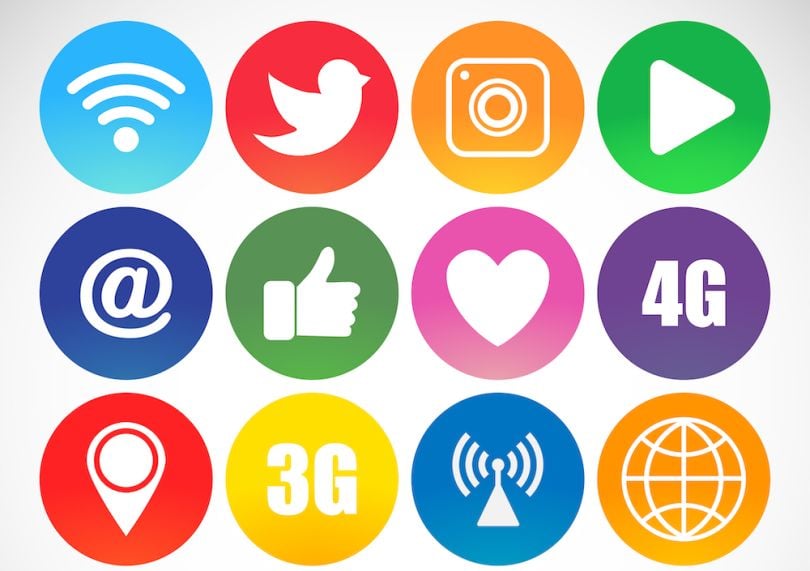Once you’ve seen a Kum & Go, it’s hard to forget. The name sticks with people. “In a way, it’s a marketer’s dream,” Ariel Rubin, the company’s director of communications, told Built In.
Of course, in another way, “it’s just kind of lewd-sounding,” he added.
Rubin often plays with the disconnect between what the name sounds like and what it actually is — a chain of gas station and grocery store hybrids — on Kum & Go’s Twitter account, which he runs.
Sometimes, he just tweets “kum & go” from the corporate account and gets hundreds of retweets. Other times, he mock-threatens people for tweeting ... roughly the same thing.

The above tweet went truly viral — but Rubin didn’t get quite as aggressive as the screenshot gallery suggests.
User @rudy_betrayed is “alive and well,” Rubin promised. “He’s tweeting.”
He isn’t any old user, either. His comedy account has more than 20,000 followers, and Kum & Go’s viral tweet was actually inspired by a viral tweet from his old, now-defunct account, @rudy_mustang. In a slideshow of screenshots, the tweet showed a fabricated argument with the shoe brand Crocs, in which the company insisted Rudy delete a tweet that said simply: “Crocs brand condoms.”
“Crocs is a family brand,” the company pleaded, in a fake DM screenshot.
“[S]eems like condoms with holes all in them would be very pro-family,” @rudy_mustang replied.
It got over a million likes, and Rubin thought “it was one of the funniest things anyone had ever done.” Now, Kum & Go’s homage to that tweet has become one of the funniest things — or at least one of the most popular — the company has done on Twitter.
But it’s an outlier. Not all tweets can get that kind of traction, and not all tweets need to; social media managers have more complex goals than “virality.”
But what are they, exactly? We asked Rubin, who oversees Kum & Go’s social presence, and Clare McKinley, content marketing specialist at adtech company Centro, what managing a company’s social media really entails.

Beyond Virality: A Social Media Manager’s Key Goals
To understand the nitty gritty, it’s important to understand the overall objectives — why do companies have social media accounts in the first place?
Every company has its own unique matrix of reasons, and B2C companies like Kum & Go aim for more massive, heterogeneous audiences than B2B companies like Centro — a demand-side platform provider that mainly needs to reach prospective adtech buyers.
But at core, all social accounts function as a piece of a brand’s voice. Social posts are often the first statements a prospective customer sees from a brand, because, as Rubin put it, “who goes to websites in 2020?”
So the social posts need to highlight the brand’s strengths and values. But they also need to build an engaged audience, or they’ll just be sharing peppy stories with no one.
It’s a balancing act.
Common Core Objectives for Social Media Managers
- Share positive company news.
- Grow the company’s audience across platforms.
- Steadily improve engagement.
- Provide consistent value to followers, through education, entertainment or both.
McKinley aims to “harness all the content and all the cool stuff that’s going on in our company behind the scenes and [show] that off on social.” This often involves highlighting Centro’s monthly webinar and its monthly podcast, Adtech Unfiltered.
Rubin, too, wants to highlight Kum & Go’s good work — both “the innovative work we’re doing as a convenience store retailer” and its charitable efforts. The company donates 10 percent of its profits to charity; recently, Kum & Go also released a (now sold-out) T-shirt with Budweiser, and all proceeds went to Folds of Honor, a non-profit that gives scholarships to fallen veterans’ families.
Both Rubin and McKinley also view steadily increasing engagement as essential to a social channel’s health, and track shares, likes and comments across multiple platforms.
Engagement requires relevance — in other words, ditching straightforward self-promotion to hop into larger social media trends and conversations. That might mean making a surprise-cake video, as Kum & Go recently did, or weighing in on industry-specific issues, like advertising’s diversity problems.
Engagement doesn’t necessarily mean virality, though — especially in the B2B space.
“I think more about consistency and providing consistent value to our audience,” McKinley said. “Our strategy is really based on being an educational resource and a thought leader for our partners and anyone in the industry.”
Being hilarious, not so much.
Not that Rubin focuses exclusively on comedy, either. Kum & Go also delves into history on its social accounts — for instance, in this thread on a new Des Moines location’s role in civil rights history — and celebrates the associates who work in Kum & Go stores.
“There are 5,000 people who work really, really hard in stores,” Rubin said, “so we always want to make sure we’re honoring that.” He added that, for him, a key success metric is “when someone tells me how proud they are to work at a Kum & Go store because we’re the ones with the funny Twitter, or we have this beautiful Instagram.”
Ultimately, a successful social strategy is all about doing two conflicting things, ideally at the same time: entertaining and educating your audience, and creating a halo around your brand.
So — what does that look like on a day-to-day basis?

A Day In the Life of a Social Media Manager: It’s Not Just Posting
Outsiders might imagine that social media managers spend all their time posting — and Rubin does focus heavily on posts. He writes Kum & Go’s tweets, and oversees Nadia Trimnell, Kum & Go’s Instagram specialist, and Evelyn Meyer, Kum & Go’s “TikTok guru.”
Primarily a writer, Rubin spends a lot of time on tweet and caption “verbiage,” he said — “probably to the chagrin of my boss ... because there’s so much other stuff to do.”
Rubin’s role spans several functions — PR, social media and more — but social media management alone encompasses several other tasks.
Common Daily Tasks for Social Media Managers
- Creating and scheduling social posts.
- Monitoring analytics.
- Reacting quickly to trends.
- Collaborating with internal stakeholders.
- Planning big-picture social strategy.
- Responding to replies and DMs.
For one, there’s pairing posts’ text with visuals. McKinley notes that infographics often do well as social images, while branded tiles give social accounts “a more cohesive look.”
It also pays to share photos of faces and show off “certain specific people in our company,” like Centro’s podcast host and senior director of media innovations and technology, Noor Naseer; it just creates “more of a connection” for followers.
There’s also scheduling posts and studying reach and engagement analytics. Here, McKinley uses Sprout Social; Later, an Instagram-scheduling app; and Facebook and LinkedIn’s native analytics tools.
That’s not to mention big-picture strategy, which can involve planning posts around major upcoming events — like Pride Month, or the upcoming election — and internal initiatives.
Especially the latter involves “a lot of collaboration with different stakeholders internally,” according to McKinley.
McKinley might work with the podcast and webinar hosts to plan their social content — which often involves a quick, social-exclusive teaser video — or touch base with leaders on key marketing campaigns, like Centro’s recent one for its Basis Assistant feature.
Rubin, too, collaborates closely with other employees, especially on the social media team. “We all work really closely together and share ideas and we’re constantly back and forth,” he said. “But everyone’s kind of an expert in their own platform.”
Finally, due to the “social” in social media, both Rubin and McKinley often interact directly with followers.
“We all work really closely together and share ideas ... but everyone’s kind of an expert in their own platform.”
“I love it whenever someone comments or tweets at us or DMs us or anything,” McKinley said. “We definitely talk directly to our audience, because we want to make sure that they know that there’s someone behind all of the social stuff who wants to answer their questions.”
At Kum & Go, the social team strives to reply to tweets and DMs too — but Rubin takes more of a divide and conquer approach. He and his colleagues forward “action-oriented” messages — about, say, wallets lost in Kum & Go stores — to a customer relations team. They also reply to some followers, but only a smattering of them.
“We’re getting more comments and more DMs now and more replies, and so [trying to respond to everyone] can become unwieldy,” Rubin said. “I think it’s a good problem to have.”
It’s the exact problem social media managers want, really: overwhelming engagement.

The Secrets to Social Success
Rubin has spent years in the social media trenches — before Kum & Go, he was head of digital content for the International Committee of the Red Cross — and one thing is clear to him: An unpaid social presence only makes sense on platforms that offer organic reach.
That’s why he’s de-emphasized Facebook at Kum & Go.
“For me, Facebook became less interesting as a platform because.... Facebook deemphasizes organic reach so much that you simply post something and then it gets like, two comments, three likes,” he said. Even if you have millions of page likes.
“It’s crazy to see how hard it is to win at Facebook if you’re not going to pay.”
“It’s crazy to see how hard it is to win at Facebook if you’re not going to pay.”
On Twitter, Instagram and TikTok, though, brands can still go viral, in theory — though in practice, they can’t do it all the time — so he focuses Kum & Go’s efforts there.
Data analytics, too, help social media managers increase and focus their organic reach — though of course, analytics can never fully replace creativity. (No data will ever tell you to tweet this.)
At Centro, McKinley is always “watching our performance on social and ... using that data to make better decisions in the future, and optimize what we’re pushing out.”
The ultimate key to success, though, for Rubin, is giving social media experts autonomy. It’s the only way to ensure timely responses — especially on Twitter, a “super reactive platform.”
“It won’t work if it requires a lot of back and forth,” he said.
So, at Kum & Go and at Centro, posting rarely requires extensive workshopping. Rubin was able to fire off his viral (and murderous!) tweet without consulting anything but his gut; Meyer, an intern freshly graduated from high school, has similar freedoms on TikTok. In just a few months, they’ve already earned Kum & Go’s TikTok account nearly 50,000 followers.
Especially in the B2C space, Rubin said: “One, you have to find the right person [for a given platform], and then two, you have to trust them.”




